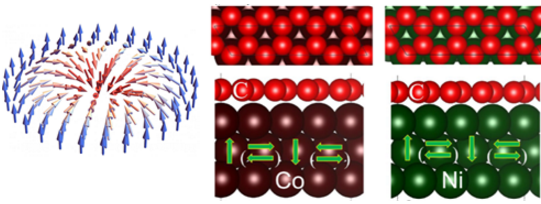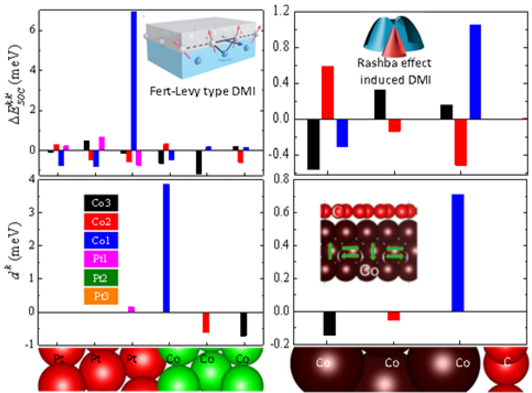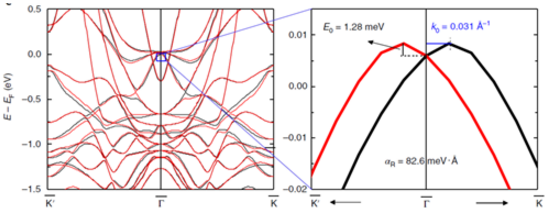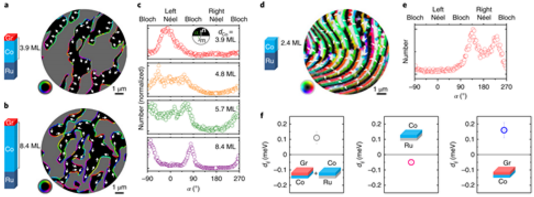Research progress on the mechanism of topographic magnetic structure of graphene/ferromagnetic metal interface
Aug 21, 2020 Pageview:1523
Magnetic sigmoid, a topologically protected magnetic vortex structure (Figure 1), is nanoscale, nonvolatile, and easy to drive, making it ideal for information storage, logic operations, or neural network technologies. The field is a hot spot from the research of spintronics in recent years. However, the application of magnetic sigmoids in spintronics devices has to solve problems such as stability at room temperature, controllable read and write, high density, and compatibility with current magnetic storage structures. The physical essence of solving the above problems is to find a suitable Dzyaloshinskii-Moriya interaction (DMI) and perpendicular magnetic anisotropy material structure.

Fig.1 Schematic diagram of magnetic sigmoid structure and Co (Ni)/graphene structure
Hongxin Yang, a researcher at the Institute of Materials Technology and Engineering of the Chinese Academy of Sciences, has been working on DMI since 2012. He has worked with Professor Mairbek Chshiev, Professor Andrea Thiaville and Nobel Prize winner Albert Fert to develop a method based on first-principles computing interfaces DMI. Successfully revealed the physical image of the ferromagnetic metal and heavy metal interface Fert-Levy type DMI from the perspective of first principles (see Figure 2 left) [HYetetal.Phys.Rev.Lett.115,267210 (2015); O.Boulle , J. Vogel, HYetal. NatureNanotech. 11, 449 (2016)], ferromagnetic metal and heavy metal interface is also the most studied system of current topological magnetic structure, however, the Fert-Levy mechanism requires non-magnetic substrate to provide strong SOC to generate large DMI (As shown in the upper left of Figure 2), the choice of substrate material is made from 5d and other heavy metal materials, and the presence of heavy metals generally affects the read and write efficiency of memory devices, and is a magnetic tunnel commonly used in the industry. The junction memory structure is incompatible, which complicates the manufacturing process. Therefore, how to break through the limitation of heavy metals, that is, to break through the Fert-Levy mechanism to achieve a larger DMI, becomes one of the field problems.

Figure 2 DMI caused by Fert-Levy type DMI and Rashba effect
In order to solve this problem, Hongxin Yang and his collaborators have conducted in-depth research on the interface between ferromagnetic metal and graphene. The structure is shown in Figure 1. It is found that the interface between single layer Co and graphene can induce DMI up to 1.14meV. The interface between the three layers of Co and graphene can induce DMI with strength of 0.49meV, and its strength can be compared with that of some ferromagnetic metal/heavy metal interface DMI. What is more interesting is that the physical mechanism of the system is completely different from Fert-Levy. Type DMI, as can be seen from Figure 2, in the Co/Pt structure, DMI is the largest in the interface ferromagnetic layer Co layer, and its energy source, that is, the SOC energy is not from the Co layer, but from the interface of the precious metal Pt layer; In graphene/Co, both DMI and SOC energy are in the Co layer. The physical origin of the difference is because the DMI at the interface of graphene/Co is the DMI induced by the Rashba effect (as shown in Figure 2), and the Co/Pt interface is Fert. -Levy type. In order to verify the DMI induced by the Rashba effect, Hongxin Yang and his collaborators further calculated the energy band variation in different magnetic directions by first-principles and calculated the Rashba coefficient. The DMI size was calculated from the Rashba coefficient to be 0.18meV, and the first principle was used. The calculated 0.49 meV is on the same order (Fig. 3) [HYetal. NatureMaterials (2018) doi: 10.1038/s 41563-018-0079-4].

Figure 3 calculates the DMI caused by the Rashba effect of the Graphene/Co interface
In synchronism with theoretical calculations, Dr. Chen Gong (a co-first author of this work) and Professor Andreas Schmid of Lawrence Berkeley National Laboratory independently measured the DMI on the Co/Graphene interface experimentally. As shown in Figure 4, the DMI is -0.05meV at the Ru/Co interface and 0.11meV at the Ru/Co/graphene dual interface. The Co/graphene interface DMI can be calculated to be 0.16meV, and the first principle is used. It agrees well with the DMI calculated by the Rashba effect.

Fig. 4 Experiments to study the magnetic domain changes of Ru/Co/graphene and Ru/Co by SPLEEM, interface DMI, and then obtain Co/graphene interface DMI
Finally, considering that the DMI chirality at the graphene/Co interface is counterclockwise, in the graphene/Ni structure, when the Ni thickness is lower than 2 atomic layers, the DMI is clockwise, so the grephene/Ni can be reversed stacking the structure to Ni/graphene to reverse its DMI chirality, thereby realizing the enhancement of DMI in the graphene/Co/Ni/graphene multilayer structure. More interestingly, the perpendicular magnetic anisotropy is also different in this structure. As the number of junctions increases, multi-layer stacking simultaneously regulates perpendicular magnetic anisotropy and DMI, thus providing more options for the regulation of topological magnetic structures (as shown in Figure 5).
55555.png
Figure 5Co(Ni)/graphene interface DMI with ferromagnetic layer thickness change (left), graphene/Co/Ni/graphene multilayer film with DMI and PMA change with heterojunction (right)
In summary, the interface between graphene and ferromagnetic metal can achieve large DMI, which is different from the Fert-Levy model. The physical mechanism is induced by Rashba effect, which breaks the dependence of interface DMI on heavy metals. In addition, considering that the Co/graphene interface also has a large perpendicular magnetic anisotropy [HYetal.Nanoletters 16, 145 (2015)], and both can be easily adjusted in the Co/graphene interface, it is foreseeable that the series will work. It provides more possibilities for the scientific research and application of spintronics and spintronics in graphene spintronics and topological magnetic structures.
The work theory was partly completed by Yang Hongxin and the University of Grenoble in France, the French National Scientific Research Center and the French Institute of Atomic Energy, SPINTEC Laboratory Professor Mairbek Chshiev, the French National Scientific Research Center and the Thales Joint Physics Laboratory Professor Albert Fert. Chen Gong and Andreas Schmid and other cooperation completed. The work was supported by the European Union's Horizon 2020 Research and Innovation Program (Graphene Flagship) and the French ANRULTRASKY, SOSPIN, Genci-Cines project, the US Office of Science, Office of Basic Energy Sciences, DOE, Office of the President Multicampus Research Programs and Initiative, and the Central Organization Youth 1000 Project and the Ningbo 3315 project.
The page contains the contents of the machine translation.
Leave Message
Hottest Categories
-
Hottest Industry News
-
Latest Industry News









